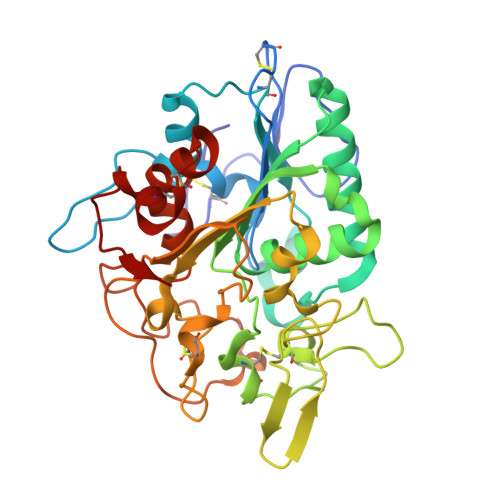The structure of PhaZ7 at atomic (1.2 A) resolution reveals details of the active site and suggests a substrate-binding mode.
Wakadkar, S., Hermawan, S., Jendrossek, D., Papageorgiou, A.C.(2010) Acta Crystallogr Sect F Struct Biol Cryst Commun 66: 648-654
- PubMed: 20516591
- DOI: https://doi.org/10.1107/S174430911001434X
- Primary Citation of Related Structures:
2X5X, 2X76 - PubMed Abstract:
Poly-(R)-hydroxyalkanoates (PHAs) are bacterial polyesters that are degraded by a group of enzymes known as PHA depolymerases. Paucimonas lemoignei PhaZ7 depolymerase is the only extracellular depolymerase that has been described as being active towards amorphous PHAs. A previously determined crystal structure of PhaZ7 revealed an alpha/beta-hydrolase fold and a Ser-His-Asp catalytic triad. In order to address questions regarding the catalytic mechanism and substrate binding, the atomic resolution structure of PhaZ7 was determined after cocrystallization with the protease inhibitor PMSF. The reported structure has the highest resolution (1.2 A) of currently known depolymerase structures and shows a sulfur dioxide molecule covalently attached to the active-site residue Ser136. Structural comparison with the free PhaZ7 structure (1.45 A resolution) revealed no major changes in the active site, suggesting a preformed catalytic triad. The oxyanion hole was found to be formed by the amide groups of Met137 and Asn49. Nine well ordered water molecules were located in the active site. Manual docking of a substrate trimer showed that the positions of these water molecules coincide well with the substrate atoms. It is proposed that these water molecules are displaced upon binding of the substrate. Furthermore, conformational changes were identified after comparison with a previously determined PhaZ7 dimer structure in a different space group. The changes were located in surface loops involved in dimer formation, indicating some flexibility of these loops and their possible involvement in polyester binding.
Organizational Affiliation:
Turku Centre for Biotechnology, University of Turku and Abo Akademi University, Finland.


















